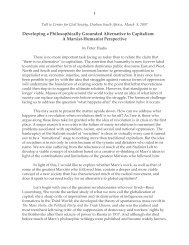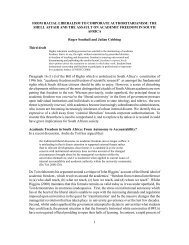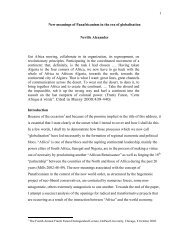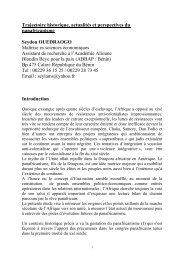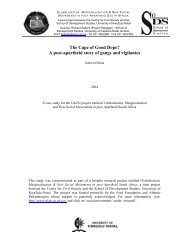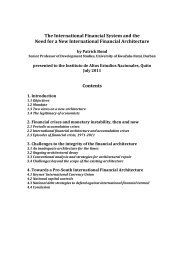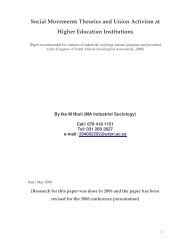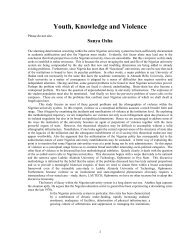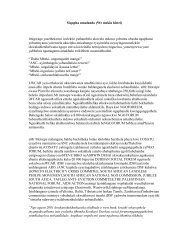April 2011 - Centre for Civil Society - University of KwaZulu-Natal
April 2011 - Centre for Civil Society - University of KwaZulu-Natal
April 2011 - Centre for Civil Society - University of KwaZulu-Natal
You also want an ePaper? Increase the reach of your titles
YUMPU automatically turns print PDFs into web optimized ePapers that Google loves.
evealed a correlation between cholera incidence and rainfall and land<br />
surface temperatures. In Djibouti, Somalia, Kenya, Mozambique, and<br />
Tanzania, cholera epidemics have been correlated with flooding as well as<br />
sea surface temperatures.<br />
Global climate drivers such as the El Nino Southern Oscillation and the<br />
Indian Ocean Dipole appear to be similarly linked to the incidence <strong>of</strong><br />
cholera. The El Nino Southern Oscillation — in which warm waters build up<br />
in the central and eastern Pacific and the Indian Ocean — creates extreme<br />
weather conditions, including floods. El Nino cycles have occurred <strong>for</strong><br />
centuries, but some scientists believe they will become more frequent and<br />
will intensify as the world warms.<br />
Scientists from the <strong>University</strong> <strong>of</strong> Michigan and the <strong>University</strong> <strong>of</strong> Barcelona<br />
analyzed 70 years <strong>of</strong> data on cholera prevalence in Bangladesh, finding an<br />
association between cholera incidence and increasingly intense El Nino<br />
events that began in 1980. Statistical modeling by scientists at the<br />
<strong>University</strong> <strong>of</strong> Santiago de Compostela in Spain found a correlation between<br />
the pattern <strong>of</strong> pathogenic vibrio infections in Peru with El Nino events, a<br />
relationship experts suspect may be responsible <strong>for</strong> a massive cholera<br />
outbreak in Peru that occurred during El Nino events in 1991.<br />
Predicted changes to the climate thanks to global warming may intensify<br />
these effects. A 2003 WHO study warned that predicted warming <strong>of</strong> African<br />
lakes, such as Lake Tanganyika, may increase the risk <strong>of</strong> cholera<br />
transmission among local people, and that countries such as Tanzania,<br />
Kenya, Guinea-Bissau, Chad, Somalia, Peru, Nicaragua, and Honduras —<br />
which suffered major cholera outbreaks after heavy rains in 1997 — may<br />
face more cholera epidemics as the climate changes.<br />
Climate change-driven storms, flooding, and heavy rainfall may lead to the<br />
spread <strong>of</strong> cholera in other ways, too. “Extreme weather events can lead to<br />
a breakdown in sanitation, sewage treatment plants, water treatment<br />
systems,” says Colwell. “And indeed, because the bacteria are part <strong>of</strong> the<br />
natural environment, we could again begin to see epidemics <strong>of</strong> cholera in<br />
the U.S. and in Europe that we haven’t seen in almost a hundred years.”<br />
Climatic and hydrological changes lead to cholera outbreaks by creating<br />
the ecological conditions in which cholera vibrios thrive. While Vibrio<br />
cholerae has been found free-living in aquatic environments, and clinging<br />
to fish, insects, and waterfowl, they are most <strong>of</strong>ten found in association<br />
with widely dispersed zooplankton called copepods. The vibrios attach to<br />
the carapace and guts <strong>of</strong> copepods, where they replicate and ultimately<br />
cover the surface <strong>of</strong> the female copepod’s egg sack.<br />
Warm, nutrient-rich water helps promote cholera vibrio growth because it<br />
leads to phytoplankton blooms, and within a week or two, corresponding<br />
spikes in copepods and other zooplankton that feed on phytoplankton.<br />
Droughts can promote the growth <strong>of</strong> cholera vibrios by increasing salinity<br />
in local waters, which helps Vibrio cholerae attach to copepods, while<br />
floods help distribute the bacteria more widely. Climatic and<br />
environmental changes may alter the local species composition <strong>of</strong><br />
copepods, some <strong>of</strong> which may play a bigger role in hosting cholera vibrio<br />
than others, says Colwell’s collaborator, the microbiologist Anwar Huq.<br />
The scientific debate over the relative role <strong>of</strong> the environment in shaping<br />
cholera recently flared into political controversy in the wake <strong>of</strong> the<br />
devastating outbreak in Haiti. Enraged rioters in Haiti blamed the United<br />
Nations’ Nepalese peacekeepers and leaky sewage pipes at their camps <strong>for</strong><br />
contaminating the country with cholera.



